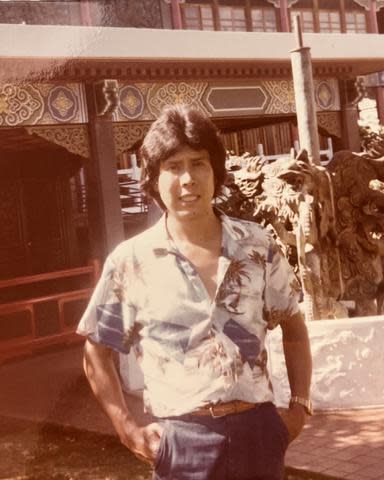Cops chased dead ends for 40 years in a California teen's cold case. Then a suspect's relative emerged.
Bound and beaten, the body of a 15-year-old girl found behind bushes just feet away from a busy Sunnyvale, California, intersection 40 years ago left police in the dark for decades.
But last year, an anonymous tip led police to focus on the men in a single family as potential suspects. And after acquiring DNA from a relative of Gary Ramirez, police said they had enough to arrest the 75-year-old Hawaii man and charge him with the 1982 rape and murder of Karen Stitt.
The discovery brought a remarkable end to a case that had previously been met with the same irrelevant suspect profiles and false leads that can be typical in cold cases. Three years after Stitt's murder, behavioral science experts at the FBI provided the Sunnyvale Department of Public Safety with a profile of Stitt's killer based on the information the police gathered. And in 2018, after the use of genetic genealogy led to the solving of several cold cases and the arrest of the Golden State Killer, Stitt's case was thrust back into the public eye.
But despite the detailed profile, advances in DNA testing and extensive investigations, detectives still were unable to identify a suspect.
So when Sunnyvale Department of Public Safety Det. Matt Hutchinson called Stitt's aunt, Robin Morris, she said she wasn't expecting much from the latest lead investigator to take the case.
“I really just expected another update like the previous update I had gotten,” Morris said.
The case began after Stitt spent a late night out with her boyfriend playing 7-Eleven video games on Sept. 2, 1982, when she was last seen alive walking to the bus stop on the corner of a busy intersection to head back home to Palo Alto.
A truck driver making a delivery found Stitt’s brutalized body the next morning in an alley near the now-closed Honey Bee restaurant. The autopsy would later reveal that the high school sophomore had been raped and stabbed 59 times, perforating her heart and lungs.
The driver told reporters at the time that the murder was “very violent” and that it looked like Stitt’s shirt was ripped off, describing “blood around her neck.” Police found Stitt’s wrists bound with that same shirt.
Police identified Stitt through her library card at the scene while her father, Robert K. Stitt, confirmed her identity four hours after her discovery.
Family plagued with loss
Just months before Stitt’s murder, the 15-year-old made the move from Pittsburgh to Palo Alto with her siblings to live with their father after their mother, Kathryn Marie Lesheski, died by suicide.
''That summer we were into forgetting it, getting the family back together,” Suzanne Arlie, Stitt’s older sister, said in a 1985 interview with the San Jose Mercury News.
Despite her mother's death, Stitt easily transitioned into her new life on the West coast, finding herself a thriving social life in California, Morris said.
Arlie, 18 at the time of Stitt's death, last saw her sister when she left to see her boyfriend in Sunnyvale. Stitt promised her that she'd be back later that night.
Instead, days later, Arlie spread her sister's ashes over Mount Tamalpais in Mill Valley, California – a place they visited often.
Even as the case went cold, Arlie continued to pursue her younger sister’s case in the decades following her murder, working closely with police.
“It was really heartbreaking to all of us but especially to her and she worked with law enforcement as much as she could, but DNA wasn’t what it is now,” Morris said. “She died right before she turned 50 years old. She never knew who killed her sister either.”
The older Stitt sister died at 49 after a long fight with ovarian cancer in 2013.

A DNA breakthrough
At the time of the crime, investigators were able to collect sperm cells and blood samples from a stain on the brick wall above where Stitt’s body was found, but it wasn’t until 18 years later that the samples could be beneficial.
In 2000, investigators were able to create DNA profiles from the sperm and blood samples lifted from the crime scene, determining both samples belonged to the same male individual and officially ruling out Stitt’s boyfriend.
The DNA was then entered into the Combined DNA Index System, but there were no matches.
With no DNA matches in CODIS, the case remained stalled until 2018, when the success of genetic genealogy in solving cases related to the Golden State Killer cases prompted Hutchinson to work with a genealogist and develop a family tree based on the suspect’s DNA.
Despite the success police had with genetic genealogy at the time, Stitt’s father wasn’t too optimistic about his daughter’s case.
“The whole thing is so painful for me,” Robert Stitt told the Mercury News in 2018. “I don’t know whether I can handle a lot of attention being paid to this. I’m not sure I could handle a trial.”
At the time, the 77-year-old had lost much of his fight, Morris, his younger sister, told USA TODAY. He died a month after his interview with the Bay Area newspaper.
“When he was last spoken to, he was very weak. I think just a lot of his fight was gone. That included any fight that he had or any expectation he had of solving this case,” Morris added. “I think by that time, he was expecting to see her in a different place…He made his peace and knew he would see her again.”
An anonymous tip
Hutchinson received a tip in 2021 that would crack the decades long cold case. The anonymous tip prompted the Sunnyvale detective to investigate the four sons of Rose Angulera Ramirez, who were living in Fresno, roughly 160 miles away from Sunnyvale, at the time of the murder.
Over the course of the next year, Hutchinson successfully eliminated two of the brothers and when he was unable “conclusively eliminate” the third one, he turned to either eliminate or identify Gary Ramirez.

Hutchinson obtained a DNA sample from Ramirez’s child after locating them earlier this year and he compared it with the DNA collected from the 1982 crime scene. The lab concluded that there was “very strong statistical support” that the DNA lifted from Stitt’s murder came from Ramirez, according to a criminal complaint.
While the DNA showed Ramirez could be the perpetrator, his whereabouts to police were still unknown.
“I didn’t know his exact location and what his status was. For all I knew he could have been deceased,” Hutchinson said. “There’s an initial moment of almost tribulation. You’re excited, you’re happy and then it becomes ‘I gotta hurry up and get him. I gotta find him. I gotta find a way to safely apprehend him and make sure that he faces this.’”
The Sunnyvale police arrested Ramirez at his home in Maui on Aug 2 and he was later extradited from Hawaii to California to face charges of rape, murder and kidnapping.
Ramirez was arraigned in the Santa Clara County Superior Court Aug. 29. Ramirez is set to enter a plea at the next scheduled hearing on Oct. 28, until then he is being held without bail, according to court documents.
“I honestly don’t think it will have an end until we have a verdict,” Morris said. “Closure for me is forgiveness, but how can you have forgiveness if no one confesses or has any remorse.”
This article originally appeared on USA TODAY: Karen Stitt cold case: California police make arrest after DNA match

 Yahoo Movies
Yahoo Movies 